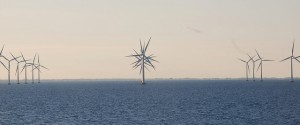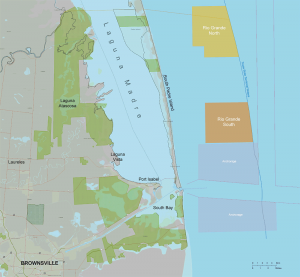How to Put a Wind Turbine in the Texas Gulf
A Conversation with Heather Otten
Texas leads the nation in wind energy, but all of that is on land. Now several groups are looking out to the Gulf of Mexico for more wind energy potential.
Heather Otten, the Chief Development Officer for Baryonyx Corporation, manages the day to day operations of one such company. As StateImpact Texas previously reported, Baryonyx is part of a group called the GoWind Project, whose plan is to bring offshore wind farms to the Texas coast by 2016.
The GoWind Project is competing with seven other offshore wind operations for money from the Department of Energy, which will choose three of the projects for full funding next Spring.
Otten recently spoke to StateImpact Texas about the progress of the GoWind Project, offshore wind’s main challenges, and dinosaurs.
Q: Why don’t we have wind turbines in the Gulf of Mexico yet?
A: I think the simple answer to that is economics. Offshore wind projects are more expensive than onshore. There’s no limit in Texas really for onshore wind, and then we have, as you know, the natural gas, the fracking and everything, so with natural gas prices so low, power prices are low. So it really is purely economics.
Q: So what’s changed in that equation so that now Baryonyx is getting closer to putting a turbine in the water?
A: Actually not a lot. But you look at the long term volatility, and you assume that gas prices are not going to stay this low. But the beauty of wind power is it’s a fixed cost. You don’t have fuel costs, it’s up front cost. [Wind power] is a good backup.
Q: Then how long will it be until we have offshore wind in the Gulf?
A: The hope is to have in by the end of 2016 into 2017. As far as the commercial-scale build out, that will hopefully follow right along that.
Q: Are you concerned at all about hurricanes?
A: We’re not particularly concerned about hurricanes because we’re doing all the proper study and research. The foundations are built with an air gap … above the highest wave. I’m not an engineer, but there’s a formula there. It’s similar technology to what all the offshore oil rigs use. We’re using a similar foundation, it’s basically what they call a jacket design. You have 4,000 oil rigs off the Gulf of Mexico [with a jacket design], we’re using what they know and improving on it.
Q: A lot of people are concerned with whether or not offshore wind will change the way the coast looks. Have you heard from the public at all in reference to those issues?
A: We have. There’s concern. Folks are concerned that it’s going to ruin their viewshed on South Padre Island. But we are 5 to 10 miles offshore, so the visibility is not going to be huge. It’s interesting, just this past week I was out in the [United Kingdom] and I went and visited a project that is the same size [as Baryonyx’s turbines], and the same distance offshore, and you could barely see them. You wouldn’t see them unless you were looking for them. And I was quite surprised by that actually.
Q: Did you get a chance to talk to any of the people around that area who may have had trepidation in the past [about an offshore wind project]?
A: No, I didn’t, but that was something we discussed. We wanted to follow up and see what the folks who were opposed to it initially thought of it now. Because honestly, being out there, I can’t imagine that anybody notices it. It was really strange to go out there and look at it.
Q: What about wildlife? The Texas coast is one of the best birding locations in the world. Are you concerned about migration patterns?
A: There’s definitely a lot of concern about migration patterns and we are getting ready to initiate our avian and bat studies. The thought is, and hopefully this is what the studies will show, is that the birds are migrating at a much higher height than [the turbines].
Q: So that’s not a concern because they’re going to be flying over it, ideally?
A: Ideally, but that’s what we’ll find out through the study process.
Q: Could you [explain] the economic impact that these projects are going to have?
A: You have the project-related jobs, that’s several hundred for construction just for the project. But what that doesn’t account for, and I can’t even estimate what the numbers are, are the people who go into the fabrication. Or the people at the port of Brownsville, since we’ll be using the docks there. And all of those people for the indirect jobs.
Q: What happens if you’re not one of the three projects selected for further funding [by the Department of Energy]?
A: I think that you still legitimately can move forward. It will probably change the timing. The Department of Energy money will help us speed up our case. I still think there’s a case to be made that offshore can make sense in Texas. Texas makes a lot of sense for offshore. It’s a great place to try it out in the states.
Q: Baryonyx is the name of an eight-feet tall fish eating dinosaur.
A: That is correct.
Q: Why [is your company] called Baryonyx?
A: You know, I would have to defer to the owner of the company. The guy who started the company is a fellow named Ian Hatton, and he was responsible for developing the Ormonde Project, which is the largest commercial installation of large-size turbines in the world right now. So he, and I believe a drinking buddy, were sitting around and decided that that was the name was the company. Way before my time.


